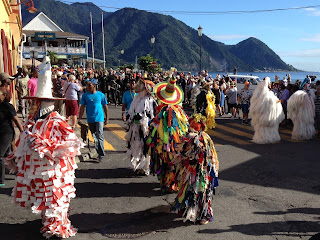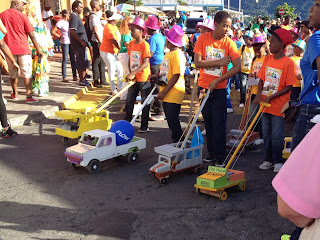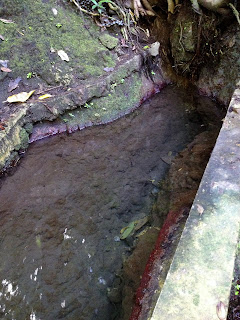On Friday afternoon, I decided to explore some of the tidal pools on the rocky ledges that are only exposed at low tide. I had first glimpsed these hard-to-reach tidal pools during my trip to the bat cave, but didn't have time to explore them—as I explained in the article I wrote about that adventure.
It requires some effort to reach this area—either by climbing down a steep hillside or wading through the surf from the beach to the rocks. Since my bat cave guide had taken me down the hillside on my previous trip, I decided to hike through the shallow, low tide water this time. Soon I was up on this pock-marked expanse between our beach area and the bat cave.
Because I was going to wade through the water, I brought with me the waterproof pouch that I had used back in West Virginia when kayaking. I don't really have a digital camera—I brought my old iPhone 4S on my Peace Corps journey that I use as a camera, phone, and web browsing device (when wifi is available).
However, in order to take pictures, you must remove the smartphone from the little dry bag hanging around my neck. After reaching the rocky flats and its tidal pools, I soon had out my smartphone, snapping pictures of the little fish, snails, crabs, etc. I was having a blast!
There is something about being next to the wild ocean—the surging surf, the salt spray in the air, the sound as the waves crash against the rocks. I'm glad I ended up on the Atlantic side rather than on the placid Caribbean side of the island. The magnetic appeal of the "motion of the ocean" is innate in most all of us. No wonder beach vacations are so popular!
I was being very protective of my camera at first, not wanting anything to happen to it. However, as the afternoon went on, I let my guard down. Just like the Sirens of Greek mythology luring sailors to their deaths, the tidal pools beckoned me closer to the edge of the ocean.
After taking a picture of the first sea urchin I had encountered in a tidal pool, I noticed there was a whole colony of these black, spiny creatures in a bigger pool nearer the edge. I knew it would make an excellent photograph for my blog, so I walked over to get a good shot.
Normally, the ocean runs in rhythm—most waves come in that are regular sized, but every so often a few larger waves roll in, before resuming normal size again until the next sequence. On rare occasions, a real outlier appears from nowhere—a bigger wave than the typical bigger waves. It was about the time that I bent over to snap my picture that a much larger wave than usual thunderclapped against the edge of the rocks.
I stood up quickly and turned my back to the sea, with my phone in front of my chest. Some of the water surged around my ankles, but I was in no danger of being swept off the rocks. However, the splash that had arched up into the air seemed to fall down on top of me a split second later. Unfortunately, a little bit of this “rain” got my smartphone, too.
My iPhone was in a protective cover of red soft plastic, hiding nearly everything but the front screen. I quickly wiped off the drops of seawater from the front and everywhere else. Then I noticed that the earphone jack seemed to have had a large drop hit directly into the hole. I immediately pursed my lips and sucked hard to draw out the water. I could taste the saltiness of the seawater that had lodged in the hole. Of all places for the few drops of water to hit this phone, this was probably the worst. The odds of such a lucky hit were probably the equivalent of Luke Skywalker bombing the Death Star.
What happened next is the point where I probably made a fatal mistake. I should have just called it quits, hiked back to the beach, gone straight home, and put the phone in a bag of rice. However, I thought I might have gotten lucky—maybe it didn't get that wet and was undamaged. I wouldn't know for sure until I tried it—right?
So I hit the power button and it came on—Hooray! I went ahead with my explorations and even took a couple more pictures. I thought I had dodged a bullet and that my many good fortunes were continuing. Why had I been so worried at first? However, at one point later, I tried to turn it on to take another picture and it didn't come on. Uh oh!
I have since learned from researching the internet at home that I should have left the power button alone and tried to immediately dry it out. Turning on the phone meant that power was going through the complicated circuitry, and any water—especially saltwater that is more conductive—can result in damage from short circuits. Hindsight is always 20/20, but I wish now that I hadn't continued to take pictures.
Once I made it home, I immediately put the phone in a bag of rice and left it overnight (some sites also recommend dropping the battery and removing the SIM card, but I didn't have the specialized tools for me to unscrew the nearly microscopic Phillips-head screws holding on the back cover). I even rotated it to different positions (as recommended by some websites) until I finally went to bed. On Saturday morning (after trying the power button again but to no avail), I took it with me to the larger town of Portsmouth to a phone repair shop. They were pessimistic about the possibilities of fixing it.
So for now, I am without a phone. I am evaluating my options at this point, but I survived seven weeks of training in St. Lucia without a phone, so I should be able to survive for awhile here until I decide what to do. Part of me is still hoping for a miracle, and that at some point I might try to turn it on again and it will actually come to life—but that hope is fading quickly.
In the meantime, try to imagine the pictures I would have had of the black crabs covered in white spots, the fish with horizontal stripes running from nose to tail, the fish with the yellow and black vertical stripes running down their sides, and of course, that colony of sea urchins that I just could not resist. It was beautiful!
Here is an older photograph that shows the water I had to wade through to get to the rocky shelf that is exposed at low tide. There is a rock wall in the shadowy area that prevents one from easily getting out to the tidal pools--you must get wet if you go this route.















































